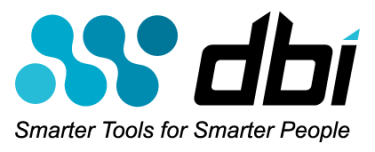By Scott Hayes, President and Founder, DBI Software
In business, you need good information to make good decisions. But how do you make sure you get good information?
I had a friend who once told me the story of a man watching Canada’s Super Bowl, the Grey Cup, one icy November when a blizzard stranded him at a ski resort in Colorado. |
 |
That year, the BC Lions were playing the Toronto Argonauts. The Lions were in the lead the entire game. However, on the last two plays, the Argos unexpectedly got the football, and there was a slight chance they could throw a fifty-five-yard pass, score a touchdown, and win the Grey Cup. The crowd in the stadium was on the edge of their seats, but the man was relaxed, confident. He told everybody in the room, “I know who’s going to win the Grey Cup. My belief is so strong, that I can assure you that in those last two plays, the Argos are going to throw that pass, score a touchdown, and win the Grey Cup.” And sure enough, the Argos threw that pass, scored that touchdown, and won the Grey Cup 18-17. Now you’re probably wondering why his belief was so strong. The answer is simple: they were watching a time-delayed replay of the game, and he already knew the final score!
In business, you need good information to make good decisions. Nowhere is this truer than with regard to your databases. It’s no exaggeration to say that when your databases are sick, your organization is unhealthy, your customers are unhappy, and your reputation suffers.
But how do you make sure you get good information? The answer is as simple to articulate as it is hard to achieve: know the end from the beginning.
If you’re a reader of these blogs, you’ll know that central to our business, and our patented, award-winning performance enhancement tools for IBM DB2 LUW software, is this three-step process that really all businesses should follow:
 |
|
Our pursuit of this process has led us to develop another industry first: Predictive Index Impact Analysis. It’s really a crystal ball that allows you to simulate changes in the indices of your database and know the exact impact throughout the system. It’s like being able to bet on a game after you know the final score.
Predictive Index Impact Analysis even allows you to compare different time-periods that encompass hundreds or even thousands of statements. It empowers you to know if changes to indexes will make your database:
- Faster
- Slower
- Or have no impact at all - and by how much
It’s the final frontier, and we’ve made it push-button simple. It’s the way business should be. Don’t close your eyes and wish for the best, instead solve the right problems, with the right tools, in the right way.
What You Must Know
You should insist that your team solves the right problem, with the right tools, in the right way.
If your IBM DB2 LUW database isn’t keeping up with performance demands, or if you’ve just been handed an emergency purchase request for CPUs and memory - or you want to prevent this from happening in the first place - contact us. We’ll diagnose any database problems for free in about 15 seconds, solve a real root-cause problem in two hours or less, and save you hundreds of thousands of dollars in CPU’s, memory, licenses, consulting fees, and wasted time. Frankly, we’re not very popular with hardware and database license vendors, but your CFO, shareholders, and customers will love us.

|
What would your business be like if it ran 4x faster? We'll present a methodology and key metrics to help you achieve rapid, measurable, and significant performance gains in your DB2 LUW databases in minutes! Register Now for a Free Webinar. |

